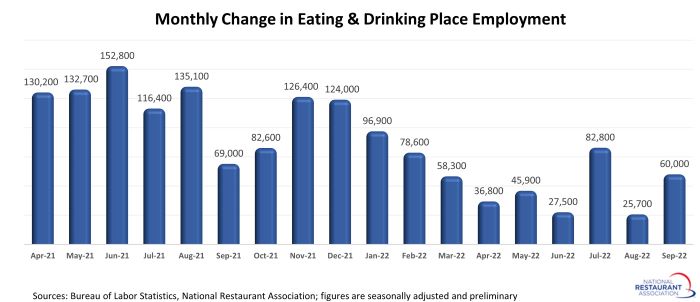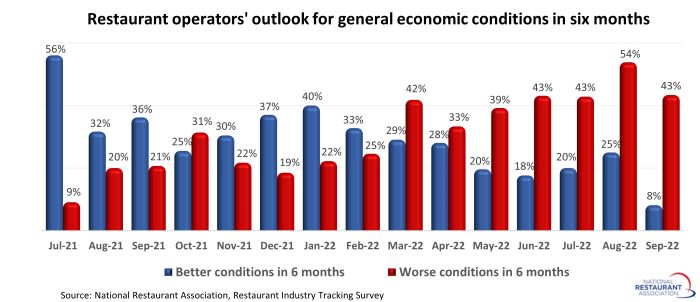Restaurants added jobs at a healthy pace in September
The restaurant industry boosted staffing levels at a healthy pace in September, even as overall job growth slowed. Eating and drinking places* added a net 60,000 jobs in September on a seasonally-adjusted basis, according to preliminary data from the Bureau of Labor Statistics.
That was up from a gain of just 25,700 jobs in August, and pushed the year-to-date restaurant employment increase above the 500,000 level.
While September’s solid increase was a positive step toward rebuilding the restaurant industry’s workforce, the road to a full recovery remains long. Eating and drinking places are still 560,000 jobs (or 4.5%) below their pre-pandemic staffing levels – tops among all U.S. industries.

Storm clouds are building
In contrast to the uptick in restaurant payrolls, job growth in the overall economy continued to slow in September. While still solid in historical terms, the 263,000 jobs added to the economy represented the smallest monthly increase since April 2021.
For their part, restaurant operators have been anticipating an economic slowdown for some time. In each of the last seven months, respondents to the Association’s tracking survey had a net negative outlook for the economy – meaning more operators expected conditions to worsen rather than improve during the next six months.
In the September tracking survey, only 8% of restaurant operators said they expect economic conditions to improve in six months. That was the lowest reading in the 20-year history of the monthly survey.
Meanwhile, 43% of operators said they think economic conditions will worsen during the next six months. The 35 percentage point gap between the two readings represented the largest net negative differential since the financial crisis in 2008.
This doesn’t mean we are about to see an economy that mirrors the 2008-2009 recession, when employers cut nearly nine million jobs. Instead, this is more likely an indication that we are currently in the midst of one of the most telegraphed economic slowdowns in history.
The Federal Open Market Committee (FOMC) has made it abundantly clear that it is willing to risk tipping the economy into recession in order to combat inflation. With two consecutive 75 basis point increases in the target range for the federal funds rate – and potentially 125 additional basis points by the end of 2022 – it certainly appears steadfast in this mission.
If economic conditions continue to deteriorate in the coming months – as many restaurant operators anticipate – the dynamics of the labor market could change quickly. An influx of job seekers into the labor pool could potentially aid sectors that are still struggling to get back to pre-pandemic staffing levels.

*Eating and drinking places are the primary component of the total restaurant and foodservice industry, which prior to the coronavirus outbreak employed 12 million out of the total restaurant and foodservice workforce of 15.6 million.
Read more analysis and commentary from the Association's chief economist Bruce Grindy.